I live in the state of California. Governor Brown was outraged (rightfully so) at the President's plan as was the rest of the world. He immediately vowed to take California in a direction opposite of that of President Trump and commit to the Paris Agreement with major nations. One of those nations was China.
Upon hearing this, I immediately wondered what does such a commitment from a state or a city official look or sound like. I was able to get a 'letter' signed by him and a chinese government official with an agreement. The letter is posted below:
Memorandum of Understanding on California-Jiangsu CleanTechnology Partnership between
State of California of the United States of America
And
Province of Jiangsu of the People’s Republic of China
To facilitate the cooperation on research, innovation, and investment in low-carbon development and clean energy resources, the State of California and Jiangsu Province (hereinafter referred to as “Participants”) signed a Memorandum of Understanding to establish a partnership on clean technology.ACKNOWLEDGING that California has a long history of successful collaboration with China, including cooperation on climate change, air quality, energy efficiency, renewable energy, new-energy and zero emission vehicle development, emissions trading systems, and climate-positive trade and investment opportunities;ACKNOWLEDGING that California has strong climate mitigation policies, including reducing greenhouse gas emissions 40% below 1990 levels by 2030, 50% renewable energy and doubling of energy efficiency by 2030, and extensive investment in clean technology development and deployment;ACKNOWLEDGING that the Province of Jiangsu has strong programs and policies designed to reduce air pollution and address climate change ,has a large number of businesses focused on innovative clean technologies, and seeks to stimulate economic growth while improving air quality and public health;ACKNOWLEDGING the opportunity to further California-Jiangsu bilateral cooperation to promote clean technology innovation and investment;STRIVING to develop a mutually beneficial relationship of partnership and cooperation to stimulate economic growth in both Jiangsu and California through business-led innovation which can draw on the research and development capabilities in both countries in order to address industrial challenges that will shape the markets of the future; andCONSISTENT with the governing laws of their respective countries:Participants have reached the following understanding:Paragraph 1OBJECTIVEThe objective of this Memorandum of Understanding (“MOU”) is to support the Participants in advancing innovation and development of, and investment in, low-carbon energy resources and clean technologies. Cooperation between the Participants will be based on a mutual understanding of shared issues and concerns of the governments and citizens of California and the Province of Jiangsu as they relate to research, innovation, and commercialization of clean technologies.To achieve these objectives, the Participants agree to develop the California-Jiangsu Clean Technology Partnership (the “Partnership”), which will allow the Participants to communicate and cooperate on matters of research, innovation, and commercialization. The Partnership will also provide a mechanism through which the Participants’ governments, researchers, key stakeholders, and industrial collaborators may exchange views, express concerns, and arrange to carry out joint actions. The Partnership will provide a mechanism to promote scientific, technological, and industrial research and commercialization cooperation between California and the Province of Jiangsu and will provide a platform for promoting mutually beneficial endeavors between the Participants, including developing markets for science and technology-based products.Paragraph 2AREAS OF COOPERATIONThe Parties agree that the areas of cooperation of the Partnership will include, but not be limited to:1. Clean energy technologies that focus on reducing energy use, improving energy efficiency, advancing renewable energy technologies such as solar and wind power, energy storage and grid modernization technologies, new-energy and zero emission vehicles, and low-carbon urban development;2. Greenhouse gas emission and air pollution reduction programs, including emissions trading systems;3. Environmental protection technologies, including pollution mitigation technologies, water and waste water technologies, and solid waste management technologies;4. Information technologies and techniques including software, advanced communication products and services benefiting the mitigation of criteria air pollutants and greenhouse gas emissions, and advancing clean energy development;5. Establishment of the California-Jiangsu Clean Tech Innovation Center in Sunan National Innovation Park (S-Park);6. Participation in the development of the California-China Clean Technology Partnership Fund;7. Other areas mutually agreed by the Participants.Paragraph 3IMPLEMENTATIONThe implementation of this MOU will be led by the Governor’s Office and Energy Resources Conservation and Development Commission from the California side and the Foreign Affairs Office, Department of Science and Technology and Commission of Reform and Development from the Jiangsu side.The Participants of this MOU will establish a Joint Working Group on the California-Jiangsu Clean Technology Partnership (hereinafter referred to as the “Joint Working Group”) to implement this MOU.The Participants will each designate a co-chair and an equal number of representatives to develop collaborative activities under this MOU and advise the Participants on ways to conduct the activities included in this MOU. The Joint Working Group will meet annually on a mutually agreed date and at a mutually agreed upon venue to discuss progress on the implementation of the MOU. Each Participant will bear its own costs in meeting its commitments under this MOU, including but not limited to any costs associated with the Joint Working Group.To implement this MOU, the Working Group will create a coordinated Joint Investment Plan that identifies projects and technologies consistent with the objectives of this MOU that may be considered as part of the California-Jiangsu Clean Technology Partnership. Each Participant will identify and fund eligible projects consistent with the Joint Investment Plan according to its own processes (“Projects”). Each solicitation for eligible Projects must include a description of the Partnership.Each Participant agrees to independently fund the activities contemplated by and being conducted pursuant to the MOU, on a contribution schedule that permits the Participants to achieve the objectives set forth under the MOU, including but not limited to any costs associated with the joint committee and implementing organizations.The Participants agree to collaborate on these Projects where possible and to share information resulting from the projects funded pursuant to the Joint Investment Plan. Collaboration may include exchange of documents, workshops, webinars, and other forms of information sharing, including in person meetings in either Jiangsu or California.Paragraph 4PARTICIPATION OF OTHER INSTITUTIONS
The Participants, by common consent, may seek the collaboration of third parties, including universities and other public and private academic and research and development institutions, or any other organizations whose activities may contribute to achieving the goals of this MOU.Paragraph 5TRANSPARENCY AND PUBLIC INFORMATIONDocuments and communications related to this MOU and its implementation may be subject to disclosure under public record laws.Paragraph 6OTHER RIGHTS AND INTERESTSThe Participants intend to adopt all appropriate measures, in accordance with their respective laws and regulations, to protect intellectual property rights and interests.Nothing in this MOU limits the right of each of the Participants to establish similar agreements with other institutions. Cooperation under this MOU does not affect the rights and obligations acquired by the Participants in other international agreements.Paragraph 7EFFECT OF MOUThis MOU serves only as a record of the Participants’ intentions and does not constitute or create any legally binding or enforceable rights or obligations, expressed or implied.Paragraph 8SUPPLEMENTARY PROVISIONSThe Participants also agree to the following provisions:1. The Participants have decided that any disagreement arising from the implementation of this MOU shall be settled in writing through amicable discussion;2. Nothing in this MOU precludes the Government of Jiangsu or the Government of California or the California Energy Resources Conservation and Development Commission from entering into any other agreement with an entity inside or outside of the People’s Republic of China or the United States of America; and3. Consultation and exchange of information and documents shall preserve the security and integrity of the systems, processes, and information (including trade secrets) of each Participant and all third parties acting on behalf of any of the Participants and be without prejudice to Participants’ legal requirements or obligations, which may prevent the exchange of certain confidential information and documents under this MOU.Paragraph 9FINAL PROVISIONSThis MOU is neither a contract nor a treaty.This MOU will be effective upon the date of signature by both participants and will remain in force for five (5) years thereafter.This MOU may be renewed for equal periods by mutual consent of the Participants until terminated through written notice.This MOU may be amended or modified by mutual written consent of the Participants.Either Participant may terminate this MOU by providing the other with 30 days written notice.Signed in Nanjing, China on June 5, 2017,in two originals in Chinese and English languages, both texts being equally authentic.
The letter was signed by Governor Jerry Brown along with the Party Secretary of the Jiangsu Province (of People's Republic of China). After reading this agreement, I find the objectives (goals) to be completely satisfactory with the movement of the renewable energy sector already. One major argument of critics of the Paris Agreement is that investment in "low carbon" technologies will cost jobs. Not so.
In a recent blog post I wrote regarding the renewable energy future, trillions of dollars are at stake by staying in the Paris Agreement -- check it out. Included in that blog post and a previous blog post on the Paris agreement are actual letters signed by big "heavy hitting" (employing hundreds of thousands of employees and revenues into the billions annually) corporations like BP and Shell along with Apple and electric companies. This is part of what makes our (the US) exit so surprising.
In fact, in a recent article from "The New York Times" titled "Our Disgraceful Exit From the Paris Accord" the following excerpt compounds the exit based on our President's background as a businessman:
Perhaps most astonishing of all, a chief executive who touts himself as a shrewd businessman, and who ran on a promise of jobs for the middle class and making America great again, seems blind to the damage this will do to America’s own economic interests. The world’s gradual transition from fossil fuels has opened up a huge global market, estimated to be $6 trillion by 2030, for renewable fuels like wind and solar, for electric cars, for advanced batteries and other technologies.America’s private sector clearly understands this opportunity, which is why, in January, 630 businesses and investors — with names like DuPont, Hewlett Packard and Pacific Gas and Electric — signed an open letter to then-President-elect Trump and Congress, calling on them to continue supporting low-carbon policies, investment in a low-carbon economy and American participation in the Paris agreement. It is also why Elon Musk, chief executive of the electric vehicle maker Tesla, was resigning from two presidential advisory councils after Mr. Trump announced the withdrawal from Paris.
If you add the number cited in the above excerpt of 630 businesses along with the 400 cited in my previous blog posts, you are looking at just over a thousand business entities that are interested in renewable energy investment who took the time to write the President a letter regarding our position in the Paris Agreement (i.e. stay in the Paris Agreement Please!).
As we have seen over the last few months, President Trump goes off of instinct (which defies scientific reasoning along with logic) and makes dangerous decisions. Here is the response of newly elected President Macron of France regarding the U.S. withdrawal on Twitter:
Meanwhile, the rest of the world continues to move forward with the Paris Agreement (limits which are self imposed -- the easiest to follow and define). Here is a twitter post regarding a new "floating solar" farm in China:
These investments are massive. According to the letter above, the goals were not necessarily completely associated with renewable energy. Take for instance our energy grid. The electrical grid in each U.S. city is degrading and is in need of a large repair. Every so often, a news article will pop up and leak testing done by the government on sending "testing threats" to the grid to see how our aging grids can handle them. This is a reactive step. Imagine if we were a proactive nation on these renewable energy goals. Thank goodness Governor Brown realizes that these steps are greatly needed.
Before I close with a few tweets from another famous past Governor (Arnold Schwarzenegger), I just wanted to share with you a tweet from the CEO Jeff Immelt of General Electric after the U.S. withdrawal along with a tweet from Governor Tom Wolf above:
Again, the world is changing toward an energy efficient and environmentally conscious world where its inhabitants are caring instead of profit seeking at the expense of destruction.
Finally, a message from the wonderful actor and former California Governor Arnold Schwarzenegger in a tweet to President Trump regarding his idea of taking the nation back in time - shown below:
Former Governor Schwarzenegger was implying that one man cannot take the nation back in time to one that is 'unregulated' and 'without safety nets' for its citizens. The movement forward will take the entire nation as a whole, not just one man. In closing, I wanted to break up another portion of his twitter post (video) with a message regarding 'great leaders' -- since we are in an existential crisis in need of a great leader. With this in mind, the following set of images will compose the conclusion to the blog post above. The above content shows what an agreement looks like without the entire U.S. commitment. Furthermore, the movement mentioned above indicates a change on the horizon ahead. A change that is geared toward a more sustainable world that is cleaner and healthier. The best way to be part of this is to invest mental or physical energy into learning about the transition.
A Concluding Remark From Arnold...
Until next time, have a great day!!!!!
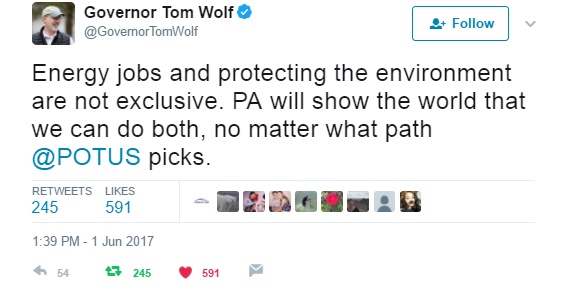
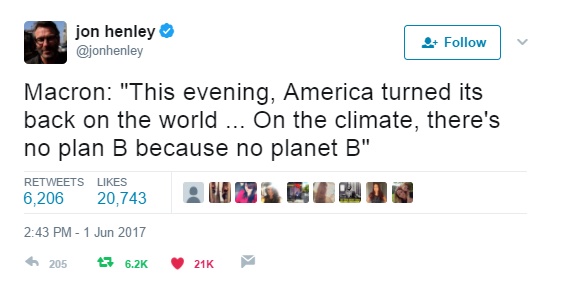

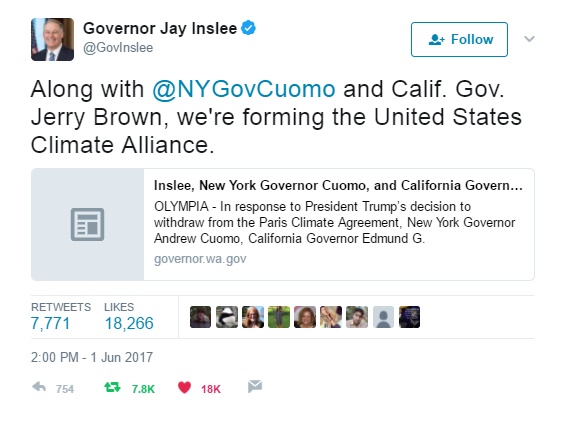
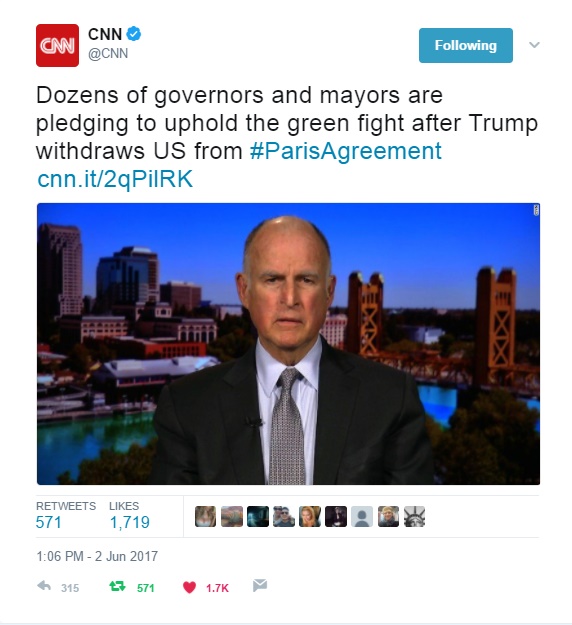
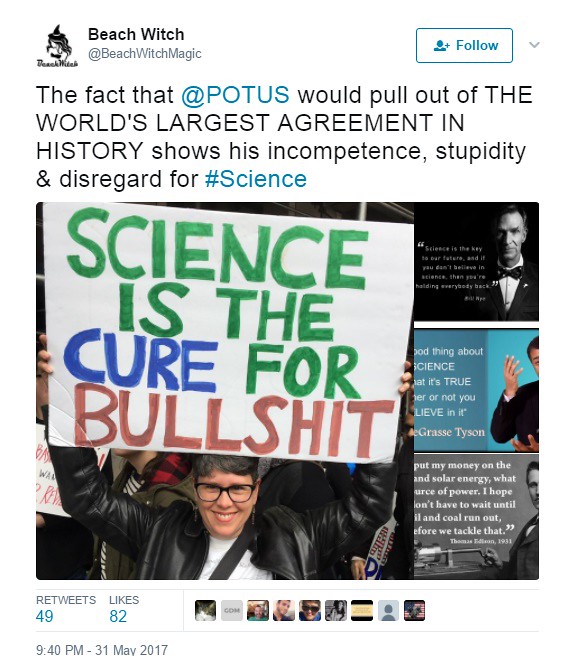
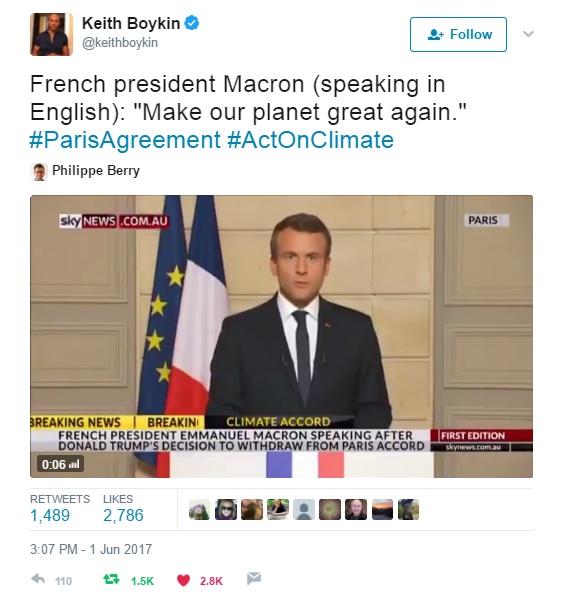


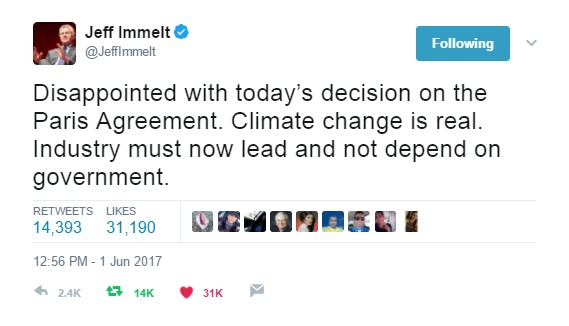
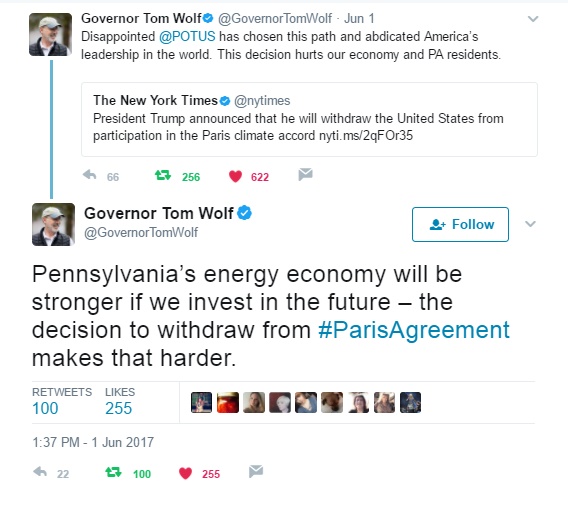
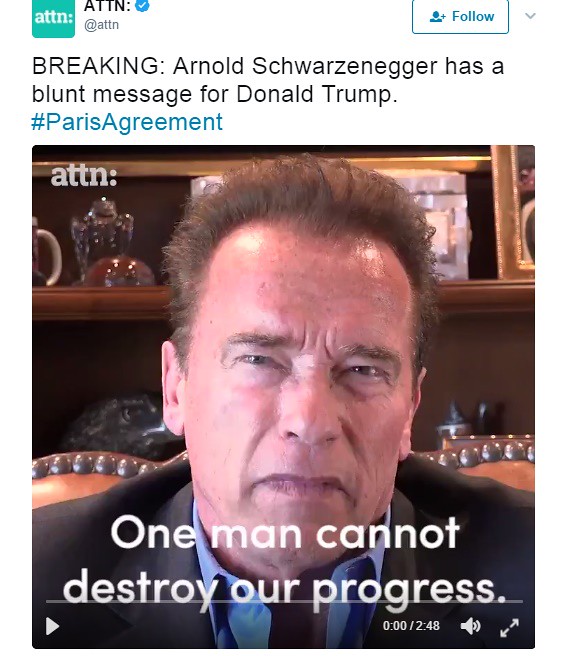

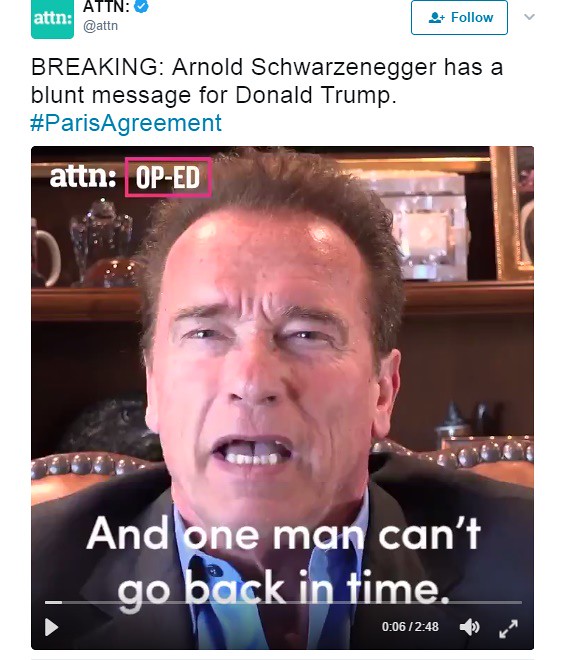
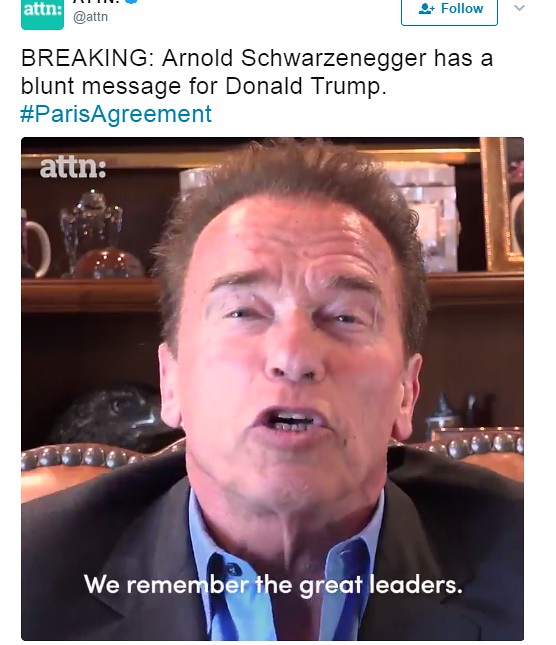
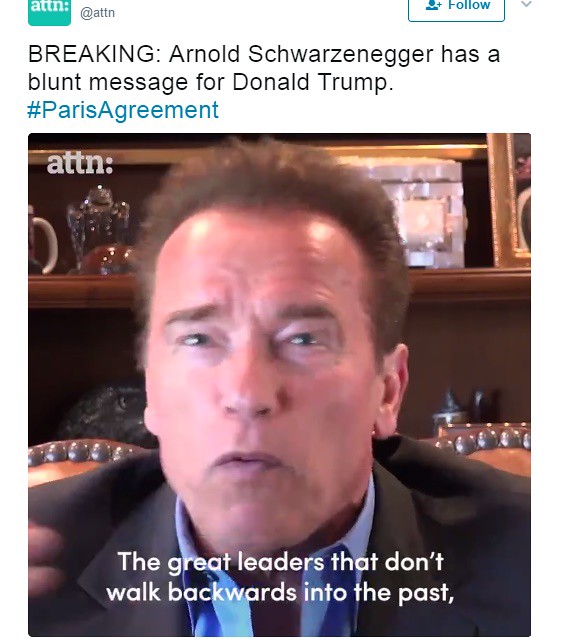
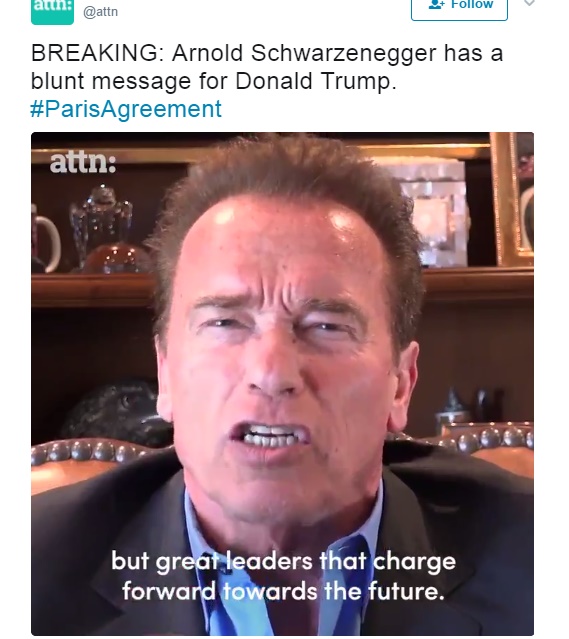




No comments:
Post a Comment